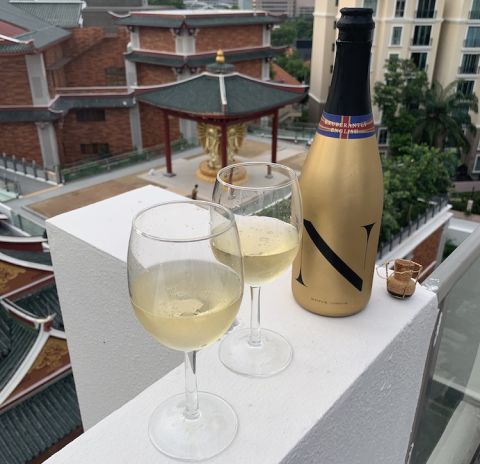Sometimes the best food match is simply the most expedient. So it proved when I was faced with the freshly cleaved skull of a whole-roasted duck, with the enticement that the brains within taste like liver. I grabbed the chopsticks, winkled out the organ and chomped it down.
It turns out that Margaret River Chenin Blanc (this one, in fact) is the perfect pairing, it being cold, cleansing and immediately available in sufficient quantity. Suddenly, my immersion into the Asian wine world felt decidedly more authentic.
Six weeks after arriving in Singapore, I have been busy getting to know the wine scene – from importer lunches to sommelier masterclasses and duck-brain dinners – and am learning fast. For example, the nature of banquet dining – where many dishes are served simultaneously, with multifarious flavours ranging from bird’s nest soup to durian sorbet – means that wine matching is speculative at best.
But in fact, for the most part, the wine scene here is reassuringly similar to the London equivalent. And, incidentally, since I come from a country whose culinary delicacies include pork scratchings and pickled eggs, I’m definitely not judging.
As a wine drinker, I have found the breadth of choice impressive. Since arriving, I’ve purchased a Savoie Mondeuse, a Mallorcan red blend, several bottles of the export-only English sparkling cuvée from Nyetimber shown below (now discontinued), oaked Sauvignon Blanc from Stellenbosch and many others. Yes, wine is expensive here, partly because duty per bottle is around SG$9 (£5.35, €5.90, $6.48), but otherwise, Singaporean wine shelves are largely indistinguishable from British ones.
As a wine professional, I find the similarities continue, and it has been intriguing to get to know the business side of the industry. Most of the time, we keep such procedural details off these pages, but the complicated structure of the Singapore wine trade is, I think, a revealing reflection of wine itself.
For context, there are 5.8 million people in Singapore today – one million more than existed just ten years ago. The catalyst for this boom was the global financial crisis in 2008, which prompted a significant immigration programme to boost GDP, in turn providing a new set of thirsts to slake.
Yet the number of people who drink wine regularly is still reckoned to be pretty small, with some estimates as low as 400,000 people. Considering there are 400 importers here, serving 327 wine shops and countless bars and restaurants – not forgetting the thriving craft beer and spirits market – competition for ‘share of throat’ is fierce. (For a first-hand account of the wine business in Singapore, read this candid post from 2015.)
There is also a thriving re-export industry, I am told, serviced by bonded warehouses close to the land and sea borders with Malaysia and Indonesia, respectively. These two Islamic countries have an understandably less-developed wine trade, presenting a worthwhile opportunity for Singapore wine businesses.
For those in the retail business, rent in a premium location can be as much as SG$8,000 (£4,727, $5,790) per month for a decent-sized space. Retailers therefore often have to import wine themselves to achieve sufficient margin.
Many more specialised importers are hobbyist, selling small quantities of wine direct to consumers and restaurants alongside their day jobs. They are selling to the limited number of customers who class wine as a major hobby – a population with significant churn due to the peripatetic nature of the large expatriate workforce.
Furthermore, there are well-founded fears that the US–China trade war is prompting another recession across Asia. The adage goes that when China sneezes, Singapore gets a cold. This recent article describes a somewhat depressed outlook for the wine trade in the world’s second-largest economy. That creeping sense of unease seems unlikely to dissipate any time soon.
On the surface, however, there is no shortage of money being spent. Luxury sports cars are a routine sight on Singapore roads, including a mirror-finish McLaren that parks on my street. At a fashionable nightclub nearby, I saw Perrier-Jouët champagne being sold by the dozen well after midnight, brought to the tables by a line of leotarded girls brandishing flashing lights and whooping (the more bottles you bought, the greater the hoopla – and thus the more people would notice).
Both examples prove that there’s no accounting for taste – but again, who am I to judge? Similar stories are told about London, with wealthy Russians as the usual suspects. Out here, trust-fund Indonesians are the bogeymen.
Fine wine is therefore in plentiful supply. In my first four weeks, I’ve been served Jacques Selosse champagne, Château Haut-Brion 2009, Château d’Yquem 1981 and Dom Mongeard-Mugneret 2016 Échezeaux among others. Because duty is fixed and GST is 7%, top-shelf prices can look relatively competitive. Provenance is an important issue, however, especially concerning shipping conditions. And rumours of fakes infiltrating the market abound.
After all, we are only just over the border from the birthplace of wine's most notorious fraudster, who will be deported back to Indonesia on his release from a US jail in 15 months. I doubt he will be giving interviews, so in the meantime I will continue to chew through the Asian wine world one duck brain at a time. Pass the chopsticks.



















